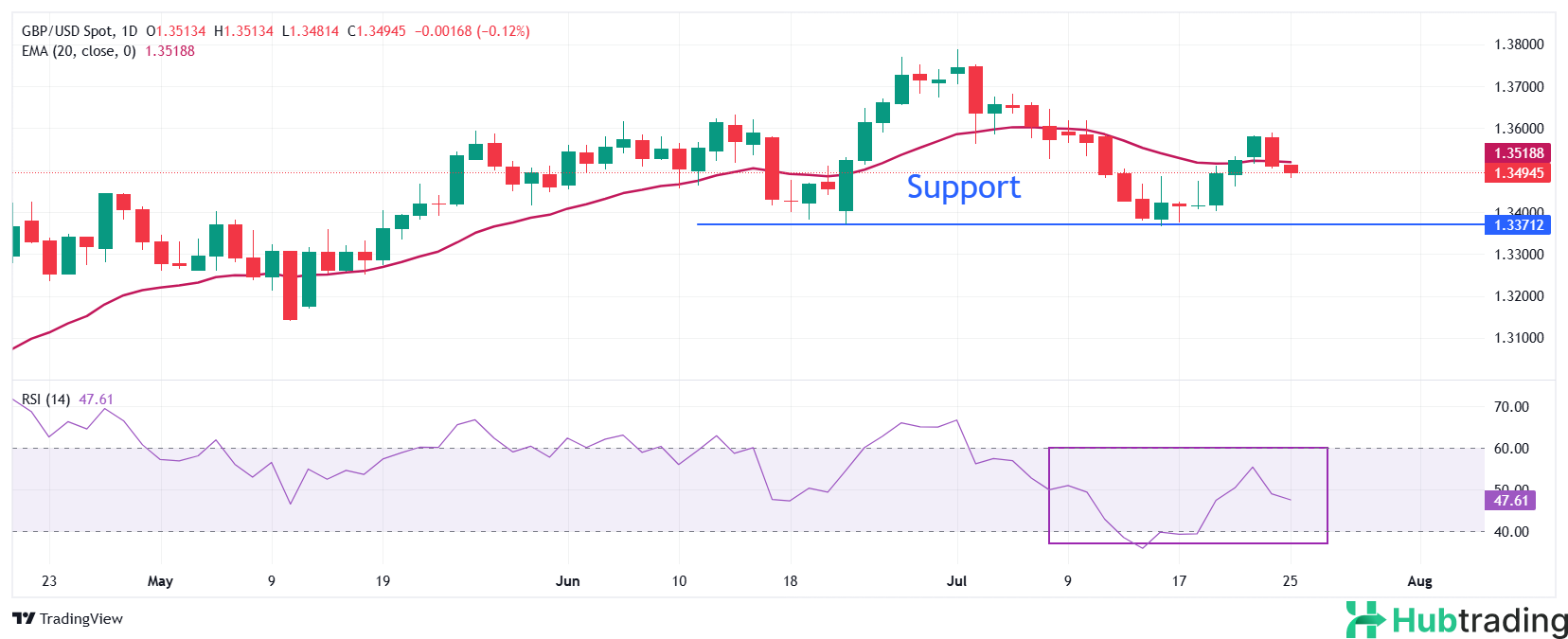-
The Pound Sterling comes under pressure as UK Retail Sales growth falls short of expectations.
-
The UK signs a Free Trade Agreement with India, fulfilling a key pledge from the Labour Party’s manifesto.
-
Market focus shifts to upcoming US economic data and the Federal Reserve’s policy decision next week.
The Pound Sterling (GBP) declined against its major counterparts on Friday after the UK Office for National Statistics (ONS) reported weaker-than-expected Retail Sales data for June, signaling subdued consumer spending. Monthly Retail Sales rose by 0.9%, missing forecasts of a 1.2% increase, following a sharp 2.7% decline in May. On an annual basis, sales rose 1.7%, slightly below expectations of 1.8%.
The modest gain in retail activity was driven by strong demand for automotive fuel and improved performance at department stores. However, this was offset by a significant drop in sales at other non-food outlets, reflecting uneven consumer sentiment.
The British Pound also remains pressured by broader signs of a slowdown in the UK’s private sector. The Flash S&P Global Composite PMI for July came in at 51.0, falling short of the 51.9 forecast and down from June’s 52.0 reading. The data highlights sluggish business momentum amid ongoing global trade uncertainty and a cautious hiring environment, further dampening support for the currency.
Looking ahead, investor attention turns to the Bank of England’s (BoE) upcoming interest rate decision in August, which is expected to play a pivotal role in shaping GBP’s direction.
On the fiscal front, the UK finalized a Free Trade Agreement (FTA) with India on Thursday. Prime Minister Keir Starmer welcomed the deal, emphasizing its potential to expand trade in key sectors such as liquor, textiles, and automobiles. The agreement also fulfills a key commitment from the Labour Party’s election manifesto and is seen as a significant step in strengthening post-Brexit trade relations.
Daily Digest Market Movers: Pound Sterling Slumps Against US Dollar as Fed Takes Center Stage
- The Pound Sterling (GBP) fell to near 1.3480 against the US Dollar (USD) during Friday’s European session, extending its decline as the Greenback gained traction amid rising expectations of a trade agreement between the United States (US) and the European Union (EU). A report from the Financial Times (FT) on Wednesday revealed that both economies are close to finalizing a tariff deal, boosting demand for US assets and strengthening the Dollar.
- Optimism surrounding Washington’s recent trade deals is easing market fears about the long-term impact of US President Donald Trump’s aggressive tariff policy. Earlier this week, the US finalized a trade agreement with Japan, slashing both baseline and automobile tariffs to 15%, further fueling confidence in the administration’s strategy.
- However, concerns persist about the inflationary effects of these tariffs. The latest US Consumer Price Index (CPI) report showed early signs of rising prices linked to tariff policies. Investors now turn their attention to the upcoming Personal Consumption Expenditures (PCE) Price Index data for June and Q2, due next week, for additional insights into inflation trends.
- The major upcoming catalyst for the US Dollar will be the Federal Reserve’s (Fed) monetary policy decision scheduled for Wednesday. According to the CME FedWatch Tool, markets widely expect the Fed to keep interest rates unchanged within the 4.25%–4.50% range. With little chance of a rate change, market participants will closely analyze the Fed’s policy statement and Fed Chair Jerome Powell’s remarks for clues on the path of future interest rates and inflation expectations.
- Meanwhile, during Friday’s session, investors are also watching the release of US Durable Goods Orders for June at 12:30 GMT. Economists anticipate a sharp 10.8% monthly decline in new orders, which could weigh on overall sentiment.
Technical Analysis: GBP/USD Slides Below 20-Day EMA, Trend Turns Bearish

The Pound Sterling extended its pullback to 1.3480 on Friday after failing to sustain gains above 1.3600 earlier in the week. The GBP/USD pair has slipped back below the 20-day Exponential Moving Average (EMA), suggesting a weakening short-term outlook and confirming a bearish near-term bias.
The 14-day Relative Strength Index (RSI) hovers within the neutral 40.00–60.00 range, indicating a lack of strong momentum in either direction.
On the downside, the key support to watch is the May 12 low at 1.3140. To the upside, the July 1 high near 1.3790 remains a significant resistance level that bulls would need to overcome to shift momentum back in their favor.





